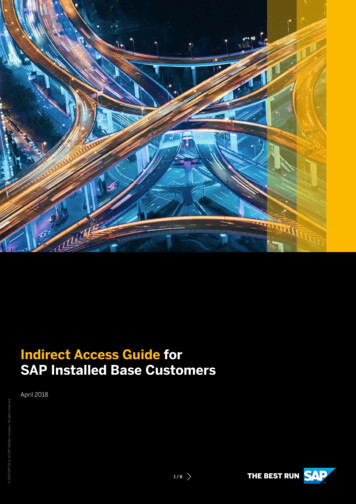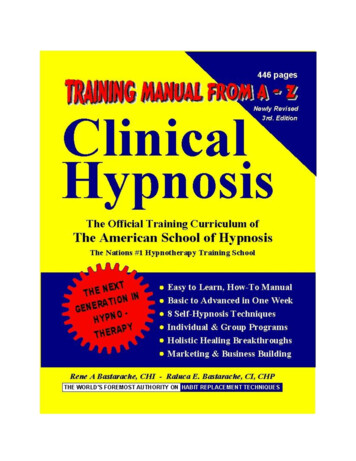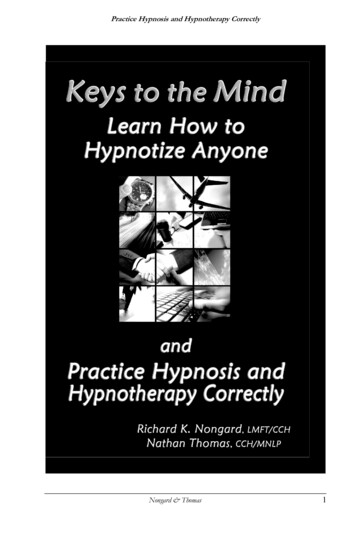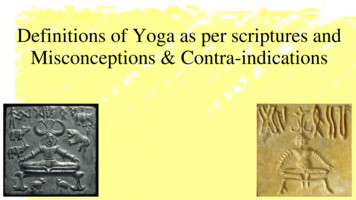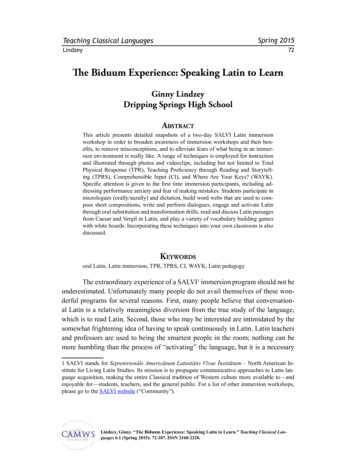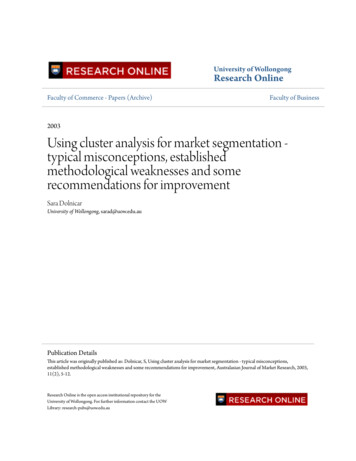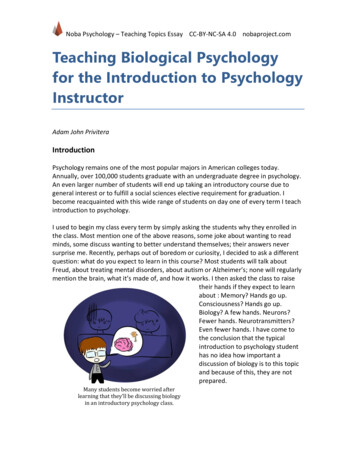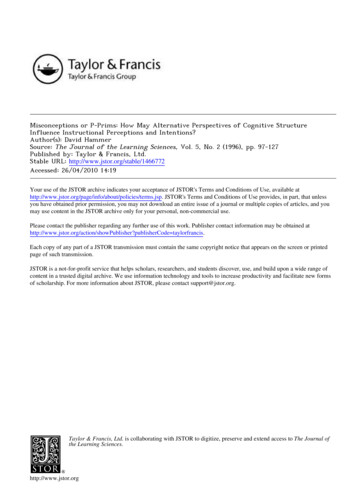
Transcription
Misconceptions or P-Prims: How May Alternative Perspectives of Cognitive StructureInfluence Instructional Perceptions and Intentions?Author(s): David HammerSource: The Journal of the Learning Sciences, Vol. 5, No. 2 (1996), pp. 97-127Published by: Taylor & Francis, Ltd.Stable URL: http://www.jstor.org/stable/1466772Accessed: 26/04/2010 14:19Your use of the JSTOR archive indicates your acceptance of JSTOR's Terms and Conditions of Use, available rms.jsp. JSTOR's Terms and Conditions of Use provides, in part, that unlessyou have obtained prior permission, you may not download an entire issue of a journal or multiple copies of articles, and youmay use content in the JSTOR archive only for your personal, non-commercial use.Please contact the publisher regarding any further use of this work. Publisher contact information may be obtained herCode taylorfrancis.Each copy of any part of a JSTOR transmission must contain the same copyright notice that appears on the screen or printedpage of such transmission.JSTOR is a not-for-profit service that helps scholars, researchers, and students discover, use, and build upon a wide range ofcontent in a trusted digital archive. We use information technology and tools to increase productivity and facilitate new formsof scholarship. For more information about JSTOR, please contact support@jstor.org.Taylor & Francis, Ltd. is collaborating with JSTOR to digitize, preserve and extend access to The Journal ofthe Learning Sciences.http://www.jstor.org
THEJOURNALOFTHELEARNINGSCIENCES,5(2),97-127@ ceptionsor P-Prims:How MayAlternativePerspectivesof sand Intentions?David HammerDepartmentof EducationTuftsUniversityThe notion that studentscome to science courses with misconceptionshas becomequite widely accepted by those who follow or participatein education research.DiSessa and his colleagues (diSessa, 1988, 1993; Smith, diSessa, & Roschelle,1993/1994) have challengedthe theoreticalandempiricalvalidityof this perspectiveand offered an alternativeaccountof cognitive structurein phenomenologicalprimitives or p-prims.The purposeof this articleis to furtherclarifyand contrastthe twoaccounts:in particular,to considertheirutility and generativityas conceptualtoolsfor teachers. How may each perspective influence instructionalperceptions andintentions?The articlerecountsa discussion about forces and motion from a highschool physics class, analyzeshow a teachermay perceivestudents'participationinthat discussion from eitherperspective,and considerswhat, based on those perceptions, the teachermay see as tasks for instruction.It has become widely accepted as a truth, among those who follow or participate inscience education research, that students come to science courses with conceptionsabout the world that differ from scientists', and that these misconceptions need toRequestsfor reprintsshould be sent to David Hammer,Departmentof Education,TuftsUniversity,Medford,MA 02155.E-mail:dhammer@tufts.edu
98HAMMERbe addressedin instruction.This view framesresearchdesignedto identifymisconceptions and instructiondesignedto reveal, confront,and replacethem.The wide acceptance and application of this perspective warrantsconcern,becausethereremaina numberof reasonsto questionits validityandcompleteness.Smith, diSessa, andRoschelle (1993/1994) argued,on econtradictsconstructivism:If studentconceptionsaredeeply and fundamentallydifferentfrom experts', then from what can they constructexpertconceptions?On empiricalgrounds,they arguedthatintuitivereasoning is not as consistentor stable as the misconceptionsperspectiveimplies.Smith et al. (1993/1994) built their argumentsfrom diSessa's (1988, 1993)earlierwork, andthey comparethe misconceptionsperspectiveto his "knowledgein-pieces" view of intuitive knowledge. In diSessa's model, intuitive physics ismade up of omenologicalprimitives, or p-prims for short.The misconceptionsperspective,diSessa argued,confuses emergentknowledge,acts of conceivingin particularsituations,for stablecognitive structures.As in Smith et al. (1993/1994), my purposeis to comparethe misconceptionsperspective to diSessa's p-prims account. However, rather than compare theperspectiveson theoreticalor empiricalgrounds,I comparethem in regardto theirpotentialutility and generativityas conceptualtools for teachers.How may eachof these perspectivesinfluenceteachers'perceptionsof studentsand intentionsforinstruction?In otherwords,I am not askingwhich view is more valid;I am askingwhat each view may do to shape a teacher'sawarenessand objectives.The context for this comparisonis a class discussion about forces and motionfrom a physics courseI taughtduringthe 1992 to 1993 school year at a public highschool in Massachusetts.In that discussion, the studentsexpressed a numberofviews inconsistentwith the standard,Newtonianaccount.I considertwo interpretationsof these views as (a) involving stablemisconceptionsor (b) situatedacts ofconceiving involving p-prims. In general, perceptionsof stable misconceptionssuggest tasksfor instructionof weakeningandreplacingelementsof students'priorknowledge; perceptionsof acts of conceiving suggest tasks of modifying the useof priorknowledge.The article is organized in three sections. First, ws misconceptionsandp-primsas models of cognitivestructures."AClass DiscussionAboutForcesandMotion"thenpresentsan accountof a physics class discussion, offers alternativeways in which a teacher mayperceive the students'views, andconsiderswhata teachermay supposeinstructionshould accomplish.The closing section, "ResearchPerspectivesand InstructionalPractice," summarizes the analyses and reflects on the contributionsof theseperspectivesfrom researchto instructionalpractice.
MISCONCEPTIONSOR P-PRIMS99ALTERNATIVEPERSPECTIVESON STUDENTS'KNOWLEDGEMisconceptions'As Smith et al. (1993/1994) noted, thereare many versions of the perspectivethatstudents'conceptionsare differentfrom scientists'. The students'conceptionsarereferredto variously as preconceptions,alternativeconceptions,and misconceptions, but the core idea is of conceptionsthat1. are stronglyheld, stablecognitive structures;2. differ from expertconceptions;3. affect in a fundamentalsense how studentsunderstandnaturalphenomenaand scientific explanations;and4. must be overcome, avoided, or eliminatedfor studentsto achieve expertunderstanding.Not all authors would agree with this set of properties.In particular,someconsider the term misconceptionsto refer only to the phenomenologyof patternsin students'responsesthatare inconsistentwith expertunderstanding.This use ofthe termdoes notposit cognitivestructuresoranyotherexplanationforthe observedpatterns;it simply notes the patterns'existence (D. Hestenes,personalcommunication, January21, 1994). Following Smith et al. (1993/1994), I do not intendtoattributethe list to any particularauthors,butI suggestit is consistentwith commonusage of the variousterms(preconceptions,etc.) in the science educationcommunity. For the purposesof this article,I use the most commonterm,misconceptions,and I take these four propertiesas its definition.The misconceptions perspective reflects the constructivisttenet that peopleperceive and interpretthe world throughtheir currentknowledge structures.It isan alternativeto the naive, generally tacit view that studentsare "blankslates,"accordingto which instructionconstitutesa transferof informationfromthe teacher(or textbook,or demonstration,etc.) to the students.The core idea is thatstudents'priorknowledge includesquitereasonableconceptionsthatarenot consistentwithexpert understanding.These misconceptions affect in a fundamentalway howstudentsperceive and interpretwhat they see and hear.For this reason,instruction'Refer to Smith et al. (1993/1994) and Carey(1986) for more extensive discussionsof the misconceptions perspective.
100HAMMERcannot be a straightforwardexchangeof information.It is not sufficient simply totell studentsor to show them;teachersmust help studentschange or replacetheirmisconceptions.It is thus essential for educatorsto take seriously the alternativeand intelligentconceptionsthat underliestudents'"mistakes,"ratherthan simplyto convey scientists' knowledge.AboutForcesandMotionMisconceptionsBy a Newtonian account, forces do not cause motion (velocity); they causechange in motion (acceleration).If thereis no net force on an object, it moves at aconstant speed in a constantdirection;if there is a net force, the object's speed,directionof motion,or both changes.Studentsoften have difficultyunderstandingthis account, due, from the misconceptionsperspective,to their misconceptionsaboutforces andmotion. I note severalthatarerelevantto the analysisof the classdiscussion laterin the article.McCloskey (1983) described students as having an intuitive impetus theorysimilarto the impetustheoriesarticulatedby medievalphysicists.Studentssee themotion of an objectas causedby an internallystoredimpetus,which they typicallycallforce or energy.As the impetusrunsout, the object stops moving. McCloskeyidentifiedtwo variationsof the impetustheory,one in which the impetusruns outon its own andanotherin which the impetusis drainedby gravity,friction,or both.Otherresearchershave othemthe coherenceof a theoreticalframework.Clement(1983) describedstudents'use of a misconceptionthat"motionimplies a force"in a rangeof situations.Thisis a misconceptionthatthemotionof anobjectindicatesthepresenceof a continuingforce causing thatmotion.Hestenes and his colleagues (Halloun & Hestenes, 1985; Hestenes, Wells, &Swackhamer,1992) haveprovidedthe mostcompletetaxonomyof misconceptionsrelatedto mechanics.They use the termimpetusto describeseveralmisconceptionsrelatedto an internallystoredcause of motion.Theirlist also includesthe misconceptionsthatmotionimplies an activeforce on an object,exertedby some externalagent,andthatmotionends when the activeforce "wearsout."Similarmisconceptions, of motion as caused by an externallyapplied force, have sometimes beendescribedas Aristotelian(Champagne,Klopfer,& Anderson,1980;diSessa, 1982;Whitacker,1983), althoughtheseauthorshavebeencarefulto notethatthe students'conceptions do not have the coherenceor logical structureof Aristotle's account.Othermisconceptionsin Hesteneset al.'s (1992) taxonomyincludethe conception2Moreextensive accountsof misconceptionsin mechanicscan be found in Arons (1990), Campetal. (1994), and Hallounand Hestenes (1985).
MISCONCEPTIONSOR P-PRIMS101that the strengthof gravity increasesas an object falls (Champagneet al., 1980),that obstacles (e.g., a table) do not exert forces (Minstrell,1982), and thatmotionoccurs when the motive force is largerthanthe resistinginfluences.PerspectiveChallengesto theMisconceptionsThe purposeof this article is not to debate the validity of the misconceptionsperspective. However, because of its wide acceptancein the science educationcommunity, it may be importantto review some of the criticisms of the misconceptions perspectiveto motivatethe considerationof an alternative.Some accountsof particularmisconceptionshave been criticizedas inappropriately framedwithin the scientists' position, using scientists' terms and meanings,ratherthan within the students'(Viennot, 1985). For example, if a studentsays amoving object "hasa force in it,"researchersmay interpreta misconceptionaboutforce. It is a mistake,by this line of criticism,to interpretthe student'suse of thewordforce as correspondingto a physicist's use of the term.Studentsmay have anentirely differentschema for the wordforce (Carey, 1986), or several competingschemas (Maloney & Siegler, 1993), or their concept of force may be vague in afundamentalsense (McDermott,1984). A similarcriticismholds that some of thedifferences inferredbetween studentsand scientists are a matterof terminology.Schuster(1993) showed thatchangingthe wordingof certainquestionscan have adramaticeffect: "Whichobject's speed is changing more quickly?"elicits verydifferent-and to a hasa higheracceleration?"Smith et al. (1993/1994) and diSessa (1988, 1993) challenged the idea of adiscontinuitybetween studentandexpertknowledge,arguingthatit conflicts withthe constructivistaccountof how we develop new understanding:In focusingonlyon nceptionsperspectiveoffersno accountof productiveideasthatmightserveas resourcesfor learning.Becausethey are fundamentallythemselvesflawed,misconceptionsmustbe replaced. An accountof usefulresourcesthataremarshaledby learnersis anessentialcomponentof a vefailsto provideone.(Smithet al., 1993/1994,p. 124)That is, althoughthe misconceptionsperspectivepresentsa need for conceptualchange,fromthe students'misconceptionsto the expert'sappropriateconceptions,it does not providean accountof how thatchange may take place.Finally, a numberof researchershave questionedwhetherstudentreasoningisas consistentas the misconceptionsperspectiveimplies. Most of this criticismhasbeen directed at views of student reasoning as based on coherent, alternative
102HAMMERframeworks.A numberof authorstakethe position thatnaive reasoningin physicslacks the coherenceof expertreasoning(Hesteneset al., 1992; Huffman& Heller,1995; Minstrell, 1989, 1992; Viennot, 1985). Some of these accounts not onlychallenge the view of students'having alternative,coherentframeworks,but alsoquestionthe view of incoherentcollectionsof stable,individualcognitive structures(diSessa, 1988, 1993; McDermott,1984; Viennot, 1979). These authorspoint to amalleability in the conceptions attributedto students,evident in the variationofstudents'reasoningacross differentcontexts.P-PrimsNot all thoughtsstudentsexpressneedto be understoodas .Whatthe misconceptionsperspectivetreatsas a storedconstructmay alternativelybe treatedas an act of construction.For example, in one populardemonstrationof misconceptions,studentswereaskedto explain why it is hotterin the summerthanin the winter(Sadler,Schneps,& Woll, 1989). Many respondedthatthis is because the earthis closer to the sun.To see this responseas a misconceptionis to understandit as partof the students'knowledge system: The question accessed that stored (and faulty) element ofknowledge about why it is hotterin the summer.Anotherinterpretationwould bethat the studentsconstructedthat idea at the moment.This constructionwould bebasedon otherknowledge,such as the (appropriate)knowledgethatmoving closerto the sun would make the earthhotter,but it is not necessaryto assume that theidea itself existed in some form in the students'mindspriorto the question.DiSessa (1988, 1993) developed an alternativeaccount of students' intuitivephysics knowledge, positing the existence of more fundamental,more abstractcognitive structureshe called phenomenologicalprimitives or p-prims. By thisview, how studentsrespondto a questiondependson which p-primsare activated.For example, the question of why it is hotterin the summermay activateforthem a p-prim connecting proximity and intensity: Closer means stronger. Thisp-prim is an abstractionby which one may understanda range of phenomena:Candlesarehotterandbrighterthe closer you get to them;musicis louderthe closeryou are to the speaker;the smell of garlic is moreintense the closer you bringit toyour nose. It may be throughthe activationof closer means strongerthat studentsgeneratethe idea thatthe earthis closer to the sun in the summer.Thatmost peoplewould have this primitive in their knowledge system, and that it has a highprobabilityof being cued in the seasons question,is an alternativeexplanationforwhy many studentsgive such a response.Moreover,becausecloser meansstrongeris encodedat an abstractlevel, in otherwords because it is not directly linked to any surface features of experience,different entrancesto the same topic would likely yield differentresponses. For
MISCONCEPTIONSOR P-PRIMS103example, if the question were to arise in the context of a discussion aboutthe tiltof the earth,closer means stronger may never be activatedor the p-primmay beactivatedbut applied in a differentway, leading the studentto reason thatthe tiltof the earth pushes one hemispherecloser to the sun. By the misconceptionsperspective,what is storedin some form is directlythe notion that "it is hotterinthe summerbecausethe earthis closerto the sun."By thatperspective,it is difficultto understandhow any discussion aboutwhy it is hotterin the summerwould notinvoke the misconception.In short,context sensitivity is easier to understandfrom a p-primsperspectivethan it is to understandfrom a misconceptionsperspective,because p-prims areencoded at a more abstractlevel. The p-prims perspective does not attributeaknowledge structureconcerningthe closeness of the sun and the earth;it attributesa knowledge structureconcerningproximityand intensity.Moreover,the p-primcloser means stronger is not incorrect.3Its activationin the situationof trying toexplain the seasons is incorrect,but the knowledge element itself is not. Thisdifference has practical relevance for instruction:A teacher would not try toeliminatethe p-prim.Similarly, ratherthan understandingstudentsas having a misconceptionthatmotionimpliesaforce, one mayunderstandthemas generatingsuchresponsesfrommore fundamentalknowledge elements.DiSessa describeda p-prim,which I callmaintainingagency,4thatis relatedto the misconception,except againit is encodedat a more abstractlevel. Maintainingagency is involved in an understandingof acontinuingcause thatmaintainsmotion,such as an engine maintainingthe motionof a car, but it can also be involved in understandingthat a supply of energy isnecessary to keep a bulb lit or an oven hot, or thatcontinuousencouragementisneeded to keep a student motivated. Like closer means stronger, maintainingagency is not incorrectin and of itself; its activationin certaincontextsis inappropriate.Otherprimitivesin diSessa's frameworkincludeactuatingagency, ctuatingagency is involved in understandingan initial cause of some effect, when the effect outlaststhe cause, in theway thata toss causes the motion of a ball, the strikeof a hammercauses a bell toring, or, perhaps,a traumaticevent causes anxiety. Dying away is an abstractionfromexperiences,suchas thefadingof thesoundof a bell, a decayin timeanalogousto the decay with distance of closer means stronger. Dying away may underliestudents'understandingof why a tossedball returnsto earth,as the influenceof theactuating agency fades over time. Resistance and interferenceare two p-prims3I use correct and incorrectin this articleto describeconsistency and inconsistencywith accountsthat are establishedwithin the physics community.4DiSessa (1993) called this p-prim continuingpush, but the word push in that name may bemisleading.I also use the name actuatingagency insteadof diSessa'sforce as mover.
104HAMMERpertainingto causes that impede an effect. Ohm'sp-prim5is an abstractionfromexperiences involving an agency, an effect, and an impediment:The strongertheagency, the greaterthe effect; the strongerthe impediment,the weakerthe effect.These two perspectiveson students' knowledge thus posit different kinds ofcognitive structures-misconceptions andp-prims-and these differentmodels ofknowledge point to differentinterpretationsof students'reasoning.The followingsection presents a class discussion about forces and motion in which studentsexpress a number of views that are inconsistent with the standard,Newtonianaccount. In the subsequentanalysis of the discussion, I describe how one mayunderstandtheseviews eitheras indicatingmisconceptionsoras eventsof reasoningthatinvolve the activationof more fundamentalknowledgeelements.A CLASSDISCUSSIONABOUTFORCESAND MOTIONThe purpose of this article, again, is to consider how alternativeperspectivesonstudent knowledge may influence instructionalperceptionsand intentions.Thecontextfor this comparisonis a class discussionaboutforces andmotion:How maya teacher perceive the students'reasoning in this discussion, and what may theteacherthen see as tasks for instruction?I first give some backgroundaboutthe class, and then I presentan accountofthe discussion based on multipleviewings of the videotape,multiple readingsofthe transcript,and notes I recordedthatday.Backgroundon the Class and SettingThere are about 2,000 studentsat the school, the single high school for a mostlyworking-classcity in Massachusetts.I was thereas a guest, teachingone physicsclass duringthe 1992 to 1993 academicyear.The class metdaily,for42 min,excepton Mondayswhen it met for a doubleperiod.I videotapedevery meetingfrom the3rd week of school throughApril 1st, except for occasionaltechnicalproblems.Inaddition,I recordeddaily, detailednotes and collected samplesof students'work.Therewere 22 studentsin the class, dividedevenly by gender.Sixteenwere seniors,and 6 werejuniors.The discussion detailed later took place on Thursday,November 5th, about 2months into the school year. With respect to the traditionalcontent of a physicscourse, to this point in the year the studentshad been exploringvariousaspects of5This name is due to the similaritybetween the p-primand intuitiveunderstandingsof Ohm's e,and current.
MISCONCEPTIONSORP-PRIMS 105one-dimensionalkinematics(see Hammer,1995a, for furtherdiscussion of activities early in the year). During the week that precededthis discussion, they usedmicrocomputer-basedlab materials(Thornton,1987). The final activity with thatequipmentwas to examine what happensto the speed of a cart when it is pushedwith a constant force, as measuredby a spring scale attachedto the cart. Moststudentspredictedthatthe cartwould move with constantspeed, but they all foundthat the speed increased.We discussed these resultsfor the first partof the periodon Wednesday,November4th. Some studentssuggested that the accelerationofthe cartwas constant,underconstantforce,butatthattimewe only reacheda generalconsensus thatthe speed increased.With about 15 min remainingon Wednesday,I broughtout some metal tracksandrolleda steel ballon themto presenttwo argumentsby Galileothat"anyvelocityonce impartedto a body will be rigidly maintainedas long as thereare no causesof accelerationor retardation."The first argumentis as follows. If a balls roll down one ramp and then upanother,it will roll up the second rampuntil it reaches the height from which itstarted,as long as the rampsand the ball are smooth enough so that the effect offriction on the height the ball reaches is negligible. Thus, if the up ramp has ashallowerslope thanthe down ramp,the ball travelsfartheron the up rampthanitdid on the down ramp.The more shallow the slope of the up ramp,the farthertheball travelsto reachits originalheight(see Figure1). By thisreasoning,if the secondramp were horizontal,the ball would have to roll forever,because it would neverreach its originalheight.The second argumentstartsfrom the observationthata rolling ball gains speedif it is rolling downhill and loses speed if it is rolling uphill. If uphill loses speedFIGURE 1 As the slope of the rampbecomes more shallow, the ball must travel furthertoreach its originalheight.
106HAMMERand downhill gains speed, then on a smooth, level surface the speed should beconstant.6The studentsacceptedthese argumentsreadily;in fact, a few studentshelpedme complete the explanations.I assignedhomeworkfor the next day, first, for thestudentsto readthe textbook's(Haber-Schaim,Cross, Dodge, & Walter,1976, pp.224-226) accountof Galileo's argumentsand, second, for them to come up withargumentsagainst Galileo's view that a ball will roll forever at a constantspeedunless thereis some force on it to makeit speed up or slow down. Severalstudentsprotested, saying they could not argue against what they thought was true. Iexplainedthatmy reasonsfor this assignmentwere thatI suspectedthey had otherideas"lurkingaroundin [their]heads"andthatit is importantto consideralternativepositions thoroughly.AnAccountof the DiscussionAt the beginning of class on Thursday,I drew on current events for furthermotivation, asking: "How many of you supportedfor presidentthe same personyour parentssupported?"I asked whetherthey supportedone or the otherbecausethey had thoughtcarefullyaboutboth sides of the issue or whetherit was just theirupbringing.7Teacher: My parentsvoted for the same personI voted for for president.I haveto say, well wait a minute,did I just get it from them?I grew up in afamily that had certainideas that they think, and then I think them.Does thatmean thatthose ideas areright,or does it just mean I grewup in thatfamily. . Ifyou're going to vote for Bill Clinton,you betterknow why somebody would wantto vote for George Bush. Becauseif you don't know why anybodycould ever vote for George Bush,you haven't thought it through. . I know yesterday I gave thisargumentaboutGalileo, and everybodysaid "Yeah,it makes sense.Sure, it seems right."[But] if you don't seriouslyconsiderthe otheranswer,how can you be confidentaboutthis answer?Maybeyoujusthaven't thoughtit through.these6GeorgeSmithhas calledto my attentionthe fact thatphysicists'practiceof Galileopresentedto Galileois misleading,argumentsTwoNewSciences,buthe wentonto refutethem.Inthisin ballarticle,as in theclassdiscussion,I motivationtheseargumentswillcontinuemovingata constantspeedto Galileo.Tophysicists,forNewton'sfirstlawof motion,thelawof inertia,thatanobjectwithno forceactingon it will movein a straightlineat constantspeed.deviatesfromdirect7Inthe dialogueexcerpts,ellipsesandbracketsdenotewherethe transcriptAll students'namesin thisarticlearepseudonyms.dashesdenotepointsof interruption.quotation;
ORP-PRIMS 107MISCONCEPTIONSI argued that it is importantnot only to know reasons for your side, but also tounderstandand be able to respondto reasons for the other side. Tina helped memake a comparisonbetweenwhat I was askingthemto do and what lawyers oftenhave to do: "Whetherthey believe it or not, they have to arguefor theirclient."The students seemed convinced of the value of the exercise, so I solicitedargumentsagainstGalileo. Ning was the first to volunteer.She asked me to walkacrosstheroomandlook atheras I spedupandslowed down.Frommy perspective,she explained, she was speeding up and slowing down, but therewas no force onher to make her speed up or slow down. This broughtan admiringmurmuraroundthe room, and,fromthis pointon, therewas a high level of engagement,with manyside discussionsanddebates.No one hada responseto Ning's argument,so I askedfor otherarguments.We did not returnto Ning's until the next day.Jack,referringto an experimentwe haddone earlier,said thata pendulumdoesnot swing back up to the same height from which it was released, so the ball inGalileo's first argumentshould not come back up to the same height either.Otherstudents said they thoughtthe pendulumdid swing back to the same height, butScott convinced everyone by pointing out that the pendulumeventuallystops, soit must lose a little height on each swing. Steve claimed that the pendulumlostheight in its swing becauseof friction,and, he said, Galileo was talkingabout"anideal environmentwith no friction."Jackassertedthata "pendulumhas no friction."I wrote Jack's point, that the ball would not roll to the same height, on theblackboard,and I asked for otherargumentsagainstGalileo. Penny was next.For the pendulumthe reason it didn't go up to the same heightwas becauseof gravity.So why can't you thinkof the ball rollingon the flat surfacestoppingbecauseof gravitytoo. It's going toslow down in a really small difference,so you can't even noticethe difference,but eventuallyit's going to stop because of thatlittle differenceaddingup.2 Teacher: So your argumentis that the ball is slowing down, but it's justslowing down slowly enoughthatyou can't really notice?3 Penny:Yeah becauseof gravity.4 Teacher: Because of gravity.1 Penny:Several studentsresponded;Amelia's voice was the loudest.Yeah, but Galileo was talkingaboutno gravity.If there's no gravitythen how can the ball roll down the slope?No he was talking about gravity, he was just talking about nofriction.8 Nancy:No friction,yeah.9 Teacher: So Galileo was talkingaboutgravity.5 Amelia:6 Harry:7 Steve:
108HAMMER10 Nancy: Gravity'sa kind of friction,though.11 Teacher: Gravity'sa kind of friction?12 Nancy: Yeah, because if you roll a ball down it speeds up because ofgravity.And if you roll a ball up, it slows down because of thegravitationalpull. So if you're rolling a ball horizontallythegravitationalpull is pullingit downandit slows it down, youjustcan't notice, but eventuallyit will stop.I intervenedat this point,tryingto curbthe idea that"Galileowas talkingabout'nogravity.'"13 Teacher: I don't thinkhe was thinkingof "nogravity."It's like Harrysaid,how could it have rolled down the hill if there was no gravity?Why would he even have it roll down the hill? So he wasn'tthinkingof "nogravity."It wouldn'troll down the hill, it wouldjust float.14 Scott:I reiteratedPenny's argumentand wrote it on the board:"The ball slows downgradually,so you don't notice, becauseof gravity."Steve contradictedthat view,and Nancy and Jackcontradictedhis.15 Steve:Well see the ball's not slowing down because of gravity
MISCONCEPTIONS OR P-PRIMS 101 that the strength of gravity increases as an object falls (Cha
